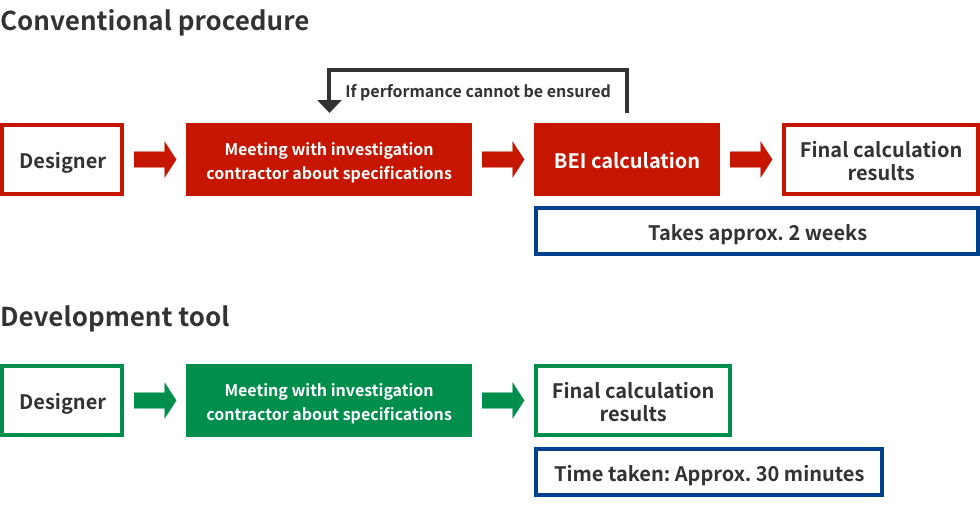Protecting the precious environment
Research and technological development: Technology to realize reduction of environmental burden
Technology related to environmental improvement
Development of "HND-NB Construction Method," a new construction method that utilizes cast-in-place concrete medium-diameter piles
In 2017, Haseko developed the "HND-NB Construction Method", a new construction method that utilizes cast-in-place concrete medium-diameter piles, jointly with Nikko Kiso and Daia Soil.
The newly developed HND-NB Construction Method allows a higher rating of drawing resistance at the enlarged base section of piles than before, in addition to further increasing bearing capacity and drawing resistance by employing piles that have a larger diameter in the middle of the shaft. The HND-NB Construction Method can use piles that are shorter than those used in the conventional HND Construction Method, while ensuring comparable bearing capacity and drawing resistance even when piles with a thinner shaft diameter are employed. This makes it possible to reduce the concrete used and soil excavated, and in turn, the vehicles required to transport them, making the HND-NB Construction Method more environmentally-friendly than the conventional HND Construction Method.
Going forward, we will proactively promote the adoption of the HND-NB Construction Method in our design and construction projects.
Development of interior thermal insulation renovation method
In condominiums, renovation of the entire building for thermal insulation may be carried out by way of insulating the exterior wall, a communal part of the condominium. On the other hand, renovation of an individual condominium unit for thermal insulation involves the difficulty of renovating the communal areas subject to condominium management regulations; therefore, a better method is to insulate inside the unit under the resident's responsibility.
A common method employed when insulating inside a condominium unit is to partially or fully demolish the existing interior surface layer of the wall, apply insulation materials to the building frame and then restore the surface layer of the wall anew. However, demolition work inside a condominium unit is a big job and burdensome to the resident, so it is not actually executed in many cases. In cases where the urethane foam spraying method is employed as a way of applying insulation materials, as done in newly-built houses, there are challenges involved including securing the necessary vehicle space for the works and examining pipe routes, etc.
On the other hand, affixing various insulation boards to the building frame—a method suited to the renovation of wooden and other detached houses—may give rise to dew condensation in the case of renovation of some of the old condominiums built many years ago where concrete surfaces with imperfections (i.e., uneven surfaces) make it difficult to affix insulation boards without gaps.
To tackle this, we have developed an interior thermal insulation renovation method with minimal concerns of dew condensation, etc. by conducting a full-scale experiment in an actual condominium unit after confirming that dew condensation would not arise if the imperfections are minor in various performance verification tests, in consideration of issues in building frame status, etc. Going forward, we plan to proactively implement this method in proposals for improving the living environment of existing housing.
Technology related to energy saving
Development of high-flow insulation reinforcement material "Tiger Insulation Flow HC" and acquisition of BCJ rating
In 2018, Haseko Corporation and Yoshino Gypsum jointly developed a new high-flow insulation reinforcement material called "Tiger Insulation Flow HC" (patent pending), and obtained BCJ rating of The Building Center of Japan (BCJ). We will proactively propose this to project owners as a pioneering technology for standards under the Act on the Improvement of Energy Consumption Performance of Buildings (energy-efficiency standards) for condominiums that meet such standards.
Development of internal ventilation specifications for units
In recent years, interest in environmental consideration and energy saving has been growing among residents, and the demand for natural energy use has also been increasing in society as a whole. Against such backdrop, people have been longing for the realization of effective ventilation inside individual condominium units. If the temperature inside a condominium unit can be lowered by opening its windows and letting natural breeze come inside, it will also help reduce the hours of air conditioner use.
To realize effective ventilation inside condominium units, it is necessary to consider the appropriate volume and route of airflow, from air inflow to outflow. Conventionally, we had adopted and proposed original items (e.g., a sash with an integrated security/privacy-conscious screen window, small window for the front hall to make the entrance brighter) to ensure natural draft. Our latest new development is a fashion door with a built-in ventilation mechanism. We have built an interior ventilation system for condominium units based on a combination of these products. By simulations and full-scale verification experiments, we have confirmed that the system has the effect of improving the living environment by 2℃ to 3℃ in spring/autumn.
Going forward, we plan to proactively propose the system so that it will actually be adopted.
Development of a design support tool for BEI calculation
In recent years, energy-saving performance requirements have become more demanding even in projects adopted in various urban development schemes of administrative agencies, etc., with a higher-than-usual Building Energy Index (BEI) being specified in some cases. This has given rise to the need to look into whether or not the condominium design meets the specified performance requirements in the planning stage. In response, an investigation contractor outside the Group conventionally looked into this, but there were issues, i.e., it was time consuming and action could not be taken promptly.
To address this, we have developed a tool that can easily predict BEI of the entire building in the planning stage. By inputting information on the block plan (e.g., location of construction, aspect, number of condominium units) and selecting the specifications of the exterior wall and facilities, this tool calculates BEI at high precision, enabling speedier action than before.
Operation of this tool was launched in April 2018; going forward, we intend to utilize it to continue proposing a better living environment.

-

- Creating attractive living spaces
-
- Providing housing tailored to diverse lifestyles
- Utilizing ICT and promoting open innovation
- Supporting interaction in local communities
- Regeneration condominiums and improving the value of housing (rebuilding, prolonging life and renovation)
- Quality management system
- Realizing safe, secure and comfortable spaces
- Developing technologies that support daily life
- Services to help bring greater peace of mind and comfort in daily life
- Contributing to the solution of social issues in housing
-

-

- Protecting the precious environment
-
- Developing the lineup of ZEH Condominiums
- Environmental management system
- Flow of materials
- Construction: Initiatives to prevent global warming
- Construction: Cyclical resource use and waste reduction initiatives
- Water resources
- Designing: Environment-conscious initiatives
- Research and technological development: Technology to realize reduction of environmental burden
- Social evaluation of environmental preservation activities
- Offices: CO2 reduction and energy-saving activities
- Environmental accounting
-

- Nurturing a culture of trust
-
- Corporate Governance
- Compliance/risk management system
- Information security and protection of personal information
- Respect of human rights
- Biodiversity conservation activities
- Next-generation development support
- Activities to protect the regional environment
- Helping resolve regional issues
- Social welfare activities
- Philanthropic activities
- Donation and sponsorship
